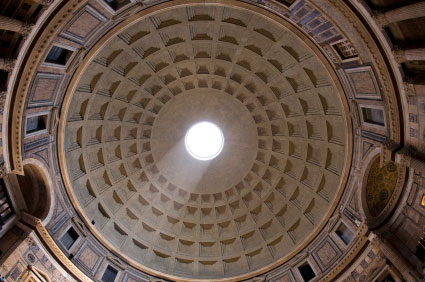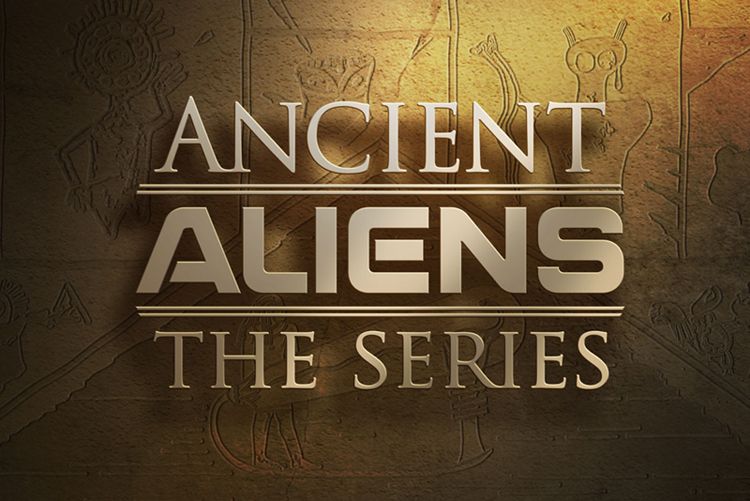Skip to comments.
The Riddle of Ancient Roman Concrete
Roman Concrete ^
| 1993-1995
| David Moore, P.E.
Posted on 09/02/2011 8:15:56 PM PDT by SunkenCiv
A most unusual Roman structure depicting their technical advancement is the Pantheon, a brick faced building that has withstood the ravages of weathering in near perfect condition, sitting magnificently in the business district of Rome. Perhaps its longevity is told by its purpose . . . to honor all gods. Above all, this building humbles the modern engineer not only in its artistic splendor, but also because there are no steel rods to counter the high tensile forces such as we need to hold modern concrete together. Describing this large circular building tells much of the intelligence of its builders; it was designed to contain a fictional ball, and is some 143 feet in diameter with a wall in the form of skirts dropping from its circumference. In the center of the dome is a 19-foot opening held in place by a bronze ring backed by a brick ring integrated into the concrete dome. This ingenious opening admitted sunlight to brighten the interior The slightly curved marble floor provided drainage and the complex notches in the walls and ceiling tell only a few features of its meticulous design.
(Excerpt) Read more at romanconcrete.com ...
TOPICS: History; Science; Travel
KEYWORDS: ancientconcrete; concrete; godsgravesglyphs; pozzolana; pozzolano; romanconcrete; romanempire
Navigation: use the links below to view more comments.
first previous 1-20, 21-40, 41-56 last
To: afraidfortherepublic
Yes, too bad we don’t have real capitalism in our country. Crony (leftist) capitalism is the culture of business now. I remember 25 years ago when “well, you have to cut corners and cheat to stay competitive!” was the mantra. Now it’s the “natural order of things.”
And the new roads every three or four years issue is rampant here in Ohio as well. In the mob-controlled counties, the work is so shoddy that they “have to” work on the roads the whole time between paving.
Someone made a mistake in my county the last time they paved the highway. It’s holding up as if it will last for quite a few more years, and it’s already on its way to the third winter. Yeah, somebody goofed big time. Whoever it was is probably already at the bottom of Lake Erie wearing cement overshoes.
41
posted on
09/03/2011 8:09:39 AM PDT
by
TheOldLady
(FReepmail me to get ON or OFF the ZOT LIGHTNING ping list.)
42
posted on
09/03/2011 8:27:10 AM PDT
by
Professional Engineer
(Who are you, and what have you done with the real John Boehner?)
To: Eye of Unk
Years ago, in the Bay Area, we knew the widow of a man who worked for Henry Kaiser at Kaiser cement. Supposedly he was the one who came up with the idea of delivering concrete already mixed in the mixer. They painted their concrete mixers lavender and used the motto “Find a hole and fill it”. Those lavender mixers chugged all over the Bay Area (CA) just mixing away. That widow hired my husband to teach her 40 year old daughter to drive. My husband wouldn’t take any pay, so the lady gave my husband her deceased husband’s watch. He still has it — 50 years later.
To: SunkenCiv
You're more than welcome, and your posts have always been informative and enjoyable.
I've built various kinds of forms and cured concrete for unusual structures in unusual circumstances (from tropical climates to never-summer places favoring yaks and wanna-be barbarians like myself).
Concrete's easy but boring for me. Properly lifted stone for random rubble builds with cured native rock is more fun and better exercise. IMO, much can be learned from picking and prying various kinds of rock by hand and playing with it more after curing. But first, one should read and learn from the old ones (from England and Africa to east Asia).
Oh... And Tai Chi Chuan keeps the arthritis away. ;-)
44
posted on
09/03/2011 1:08:15 PM PDT
by
familyop
(cbt. engr. (cbt), Army NG, '89-' 96)
To: SunkenCiv
A most unusual Roman structure depicting their technical advancement is the Pantheon, a brick faced building that has withstood the ravages of weathering in near perfect condition, sitting magnificently in the business district of Rome. 
Originally built in 27 BC by emperor Agrippa, the Pantheon was destroyed in a fire in 80 AD. Hadrian commissioned the rebuilding of the temple but there is no indication of the emperor on the building at all. Over the portico is an inscription "Marcus Agrippa, Lucii filius, consul tertium fecit" meaning "Marcus Agrippa, son of Lucius, Consul for the third time, built this"
. 
The rotunda is 43.3 m (142f) high and has a rectangular entrance with 8 granite columns. The scientists were puzzled for many years how the ancient Romans built this large dome and finally they discovered that it was made of concrete that gets lighter the higher it goes because it was mixed with lighter volcanic stones.

The Pantheon is one of the most visited sites in Rome today. It is still used as a Catholic church and holds mass daily.
45
posted on
09/03/2011 1:13:27 PM PDT
by
NYer
("Be kind to every person you meet. For every person is fighting a great battle." St. Ephraim)
To: SunkenCiv
most intersting post. the romans were astounding. visited thepantheon a few years ago and was stunned by it. it still awesome even after the later christioans mined it and modified it.
stuff the romans built still stands in perfect condition. i visited a roman aqueduct in segovia spain. even after 2000 years it still stood , you couldnt fit a knife blade between the huge stones cut to build it. all crafted without steel tools.
i think they had the internet though, so that was some help.
To: beebuster2000
47
posted on
09/04/2011 5:46:16 AM PDT
by
SunkenCiv
(It's never a bad time to FReep this link -- https://secure.freerepublic.com/donate/)
To: NYer; afraidfortherepublic
Thanks for the great pics!
48
posted on
09/04/2011 5:48:44 AM PDT
by
SunkenCiv
(It's never a bad time to FReep this link -- https://secure.freerepublic.com/donate/)
To: SunkenCiv
http://weburbanist.com/2010/09/26/bridges-that-babble-on-15-amazing-roman-aqueducts/
from the article, which btw is an outstanding find:
One wonders how many of OUR civilization’s monumental architectural works will still be around two thousand years hence.
Good question. I dont think many of the motels, malls, fast food joints, or skyscrapers will last. the roads though, yeah, they will last. we do know how to build roads.
To: tarheelswamprat
Arial view You sure it's not Times Roman? (Sorry! I just couldn't help myself!) fontroversy ping alert
To: NYer
i heard a story at the parthenon about how it was built dont know if its true.
story is, to build the structure, instead of scaffolding, the romans filled it with sand as they went. in the sand they randomly buried coins. when it was finished, they allowed the public to come in and take out sand and keep any coins that were found. place was emptied of sand in record time so the story goes.
true?
To: beebuster2000
Fascinating story. Don’t know if it is true.
52
posted on
09/04/2011 11:29:47 AM PDT
by
NYer
("Be kind to every person you meet. For every person is fighting a great battle." St. Ephraim)
To: SunkenCiv
It’s amazing how well people can do a thing if you tell them to do it, and do it well, or be fed to the lions.
To: SunkenCiv
The riddle plaguing the minds of our concrete specialists . . . how did those Romans around the time of Christ build such elaborate, ageless structures in concrete as seen on the skyline of Rome? History Channel's answer:

To: UnbelievingScumOnTheOtherSide
> In 663 Constans visited Rome for twelve days—the only emperor to set foot in Rome for two centuries—and was received with great honor by Pope Vitalian (657–672). Although on friendly terms with Vitalian, he stripped buildings, including the Pantheon, of their ornaments and bronze to be carried back to Constantinople, and in 666 declared the Pope of Rome to have no jurisdiction over the Archbishop of Ravenna, since that city was the seat of the exarch, his immediate representative. His subsequent moves in Calabria and Sardinia were marked by further strippings and request of tributes that enraged his Italian subjects.
https://en.wikipedia.org/wiki/Constans_II
55
posted on
06/06/2020 10:45:30 AM PDT
by
SunkenCiv
(Imagine an imaginary menagerie manager imagining managing an imaginary menagerie.)
To: beebuster2000
[nearly nine years later] thanks, that’ll make a good topic in its own right!
56
posted on
06/06/2020 10:59:16 AM PDT
by
SunkenCiv
(Imagine an imaginary menagerie manager imagining managing an imaginary menagerie.)
Navigation: use the links below to view more comments.
first previous 1-20, 21-40, 41-56 last
Disclaimer:
Opinions posted on Free Republic are those of the individual
posters and do not necessarily represent the opinion of Free Republic or its
management. All materials posted herein are protected by copyright law and the
exemption for fair use of copyrighted works.
FreeRepublic.com is powered by software copyright 2000-2008 John Robinson



